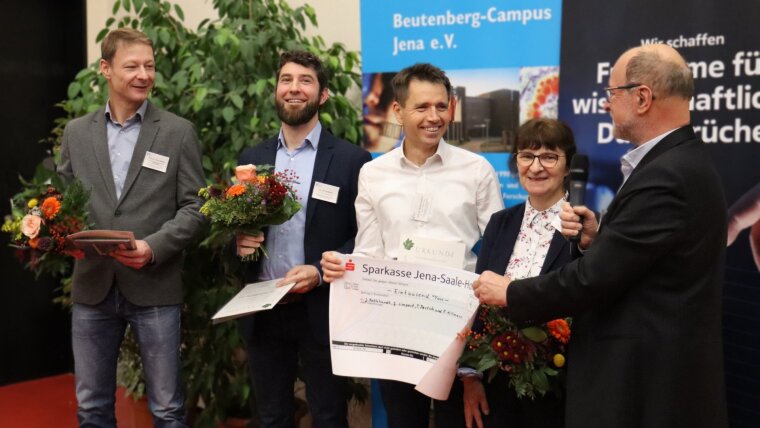
- Light
- Awards and Personnel
Published: | By: Ira Winkler
An interdisciplinary collaboration between several research institutes was honoured with the Beutenberg Campus Jena e. V. Science Award on 15 November 2023. The prize, which was awarded for the first time in the category "Excellent interdisciplinary cooperation", went to the team led by Prof. Dr Jens Limpert, Dr Jan Rothhardt and Prof. Dr Thomas Pertsch from the Institute of Applied Physics at the University of Jena, Fraunhofer IOF and Helmholtz Institute Jena as well as Dr Falk Hillmann from the Leibniz Institute for Natural Product Research and Infection Biology – Hans Knöll Institute (HKI). The researchers have developed a novel microscopy method that provides insights into the nanoworld of microorganisms in the extreme ultraviolet light spectrum. The prize is endowed with 1,000 euros.
One area of application for the new method could be infection research. In order to develop targeted cures for infectious diseases, it is necessary to know as precisely as possible about the developmental stages of pathogens and their interaction with infected cells. Extreme ultraviolet (EUV) light with a very short wavelength is particularly suitable for this, as it allows microscopy with a very high resolution (less than 20 nanometres).
Nanostructures increase the resolution
The innovative EUV microscope is based on so-called ptychography, a special form of computer-assisted, lensless imaging. The microscope uses structured EUV illumination for this purpose. This means that the radiation with which the sample is illuminated is shaped by a special mask and thus projects certain structures in the nanometre range, such as patterns or lines, onto the biological sample. The EUV masks consist of thin metal foil that is structured using a focussed ion beam.
By combining the nanostructured masks, the EUV light source and the novel EUV microscope, the Jena team was able to achieve a record resolution of 16 nanometres. In particular, the researchers analysed seedlings of the fungus Aspergillus nidulans and Escherichia coli bacteria and were able to visualise the tip body of the fungus as well as identify the chemical composition of the bacterial cell wall at different stages of cell division.
Albert-Einstein-Straße 6
07745 Jena Google Maps site planExternal link